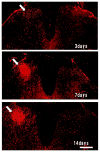Cannabinoid receptor type 1 antagonist, AM251, attenuates mechanical allodynia and thermal hyperalgesia after burn injury
- PMID: 25188001
- PMCID: PMC4237656
- DOI: 10.1097/ALN.0000000000000422
Cannabinoid receptor type 1 antagonist, AM251, attenuates mechanical allodynia and thermal hyperalgesia after burn injury
Abstract
Background: Burn injury causes nociceptive behaviors, and inflammation-related pathologic pain can lead to glial cell activation. This study tested the hypothesis that burn injury activates glial cells, and cannabinoid receptor 1 (CB1R) antagonist, AM251, will decrease burn pain.
Methods: Anesthetized rats received 0.75-cm third-degree burn on dorsal hind paw. Vehicle or AM251 30 μg intrathecally (older rats, n=6 per group) or, either vehicle, 0.1 or 1.0 mg/kg intraperitoneally (younger rats, n=6 per group), started immediate postburn, was administered for 7 days. Mechanical allodynia and thermal hyperalgesia were tested on ventral paw for 14 days. Microglial and astroglial activity was assessed by immunocytochemistry.
Results: Allodynia, observed on burn side from day 1 to 14, was significantly (P<0.05) attenuated by intrathecal and intraperitoneal AM251 (1 mg/kg) starting from 3 to 14 days. Hyperalgesia, observed from day 3 to 12, was completely (P<0.05) reversed by intrathecal and intraperitoneal AM251 (1 mg/kg). AM251 0.1 mg/kg had no effect. Microglial activity (n=3 per time point) increased (P<0.05) 18.5±7.5 and 12.3±1.6 (mean±SD) fold at 7 and 14 days, respectively. Astroglial activity (n=4 per time point) increased 2.9±0.3 fold at day 7 only. Glial activities were unaltered by AM251.
Conclusions: AM251 inhibited nociceptive behaviors after burn even beyond 7-day period of administration. Although many studies have documented the utility of CB1R agonists, this study indicates that endogenous cannabinoids may have an unexpected pronociceptive effect during development of burn pain, explaining why CB1R antagonist, AM251, improves nociceptive behaviors. The decreased nociception with AM251 without altering glial activity indicates that AM251 acts further downstream of activated glial cells.
Conflict of interest statement
COI: The authors declare no competing interests.
Figures







Similar articles
-
Nociceptive behavior following hindpaw burn injury in young rats: response to systemic morphine.Pain Med. 2011 Jan;12(1):87-98. doi: 10.1111/j.1526-4637.2010.01021.x. Epub 2010 Dec 10. Pain Med. 2011. PMID: 21143761 Free PMC article.
-
Alterations in endocannabinoid tone following chemotherapy-induced peripheral neuropathy: effects of endocannabinoid deactivation inhibitors targeting fatty-acid amide hydrolase and monoacylglycerol lipase in comparison to reference analgesics following cisplatin treatment.Pharmacol Res. 2013 Jan;67(1):94-109. doi: 10.1016/j.phrs.2012.10.013. Epub 2012 Nov 2. Pharmacol Res. 2013. PMID: 23127915 Free PMC article.
-
Activation of peripheral cannabinoid receptors attenuates cutaneous hyperalgesia produced by a heat injury.Pain. 2004 Jun;109(3):432-442. doi: 10.1016/j.pain.2004.02.020. Pain. 2004. PMID: 15157704
-
Methodology and applicability of the human contact burn injury model: A systematic review.PLoS One. 2021 Jul 30;16(7):e0254790. doi: 10.1371/journal.pone.0254790. eCollection 2021. PLoS One. 2021. PMID: 34329326 Free PMC article.
-
Multifactorial pathways in burn injury-induced chronic pain: novel targets and their pharmacological modulation.Mol Biol Rep. 2022 Dec;49(12):12121-12132. doi: 10.1007/s11033-022-07748-9. Epub 2022 Jul 17. Mol Biol Rep. 2022. PMID: 35842856 Review.
Cited by
-
Characterization of a Fatty Acid Amide Hydrolase (FAAH) in Hirudo Verbana.Neurochem Res. 2024 Nov;49(11):3015-3029. doi: 10.1007/s11064-024-04216-7. Epub 2024 Aug 2. Neurochem Res. 2024. PMID: 39093361 Free PMC article.
-
Comparative studies of endocannabinoid modulation of pain.Philos Trans R Soc Lond B Biol Sci. 2019 Nov 11;374(1785):20190279. doi: 10.1098/rstb.2019.0279. Epub 2019 Sep 23. Philos Trans R Soc Lond B Biol Sci. 2019. PMID: 31544609 Free PMC article. Review.
-
Acute and perioperative care of the burn-injured patient.Anesthesiology. 2015 Feb;122(2):448-64. doi: 10.1097/ALN.0000000000000559. Anesthesiology. 2015. PMID: 25485468 Free PMC article. Review.
-
THC Vapor Inhalation Attenuates Hyperalgesia in Rats Using a Chronic Inflammatory Pain Model.J Pain. 2024 Nov;25(11):104649. doi: 10.1016/j.jpain.2024.104649. Epub 2024 Aug 7. J Pain. 2024. PMID: 39121915
-
Insights From Molecular Dynamics Simulations of a Number of G-Protein Coupled Receptor Targets for the Treatment of Pain and Opioid Use Disorders.Front Mol Neurosci. 2019 Aug 23;12:207. doi: 10.3389/fnmol.2019.00207. eCollection 2019. Front Mol Neurosci. 2019. PMID: 31507375 Free PMC article. Review.
References
-
- Velayudhan L, Van Diepen E, Marudkar M, Hands O, Suribhatla S, Prettyman R, Murray J, Baillon S, Bhattacharyya S. Therapeutic potential of cannabinoids in neurodegenerative disorders: A selective review. Curr Pharm Des. 2014;20:2218–30. - PubMed
-
- Robson PJ. Therapeutic potential of cannabinoid medicines. Drug Test Anal. 2014;6:24–30. - PubMed
-
- Diezi M, Buclin T, Kuntzer T. Toxic and drug-induced peripheral neuropathies: Updates on causes, mechanisms and management. Curr Opin Neurol. 2013;26:481–8. - PubMed
-
- Zogopoulos P, Vaileiou I, Patsouris E, Theocharis SE. The role of endocannabinoids in pain modulation. Fundam Clin Pharmacol. 2013;27:64–80. - PubMed
Publication types
MeSH terms
Substances
Grants and funding
LinkOut - more resources
Full Text Sources
Other Literature Sources
Medical

